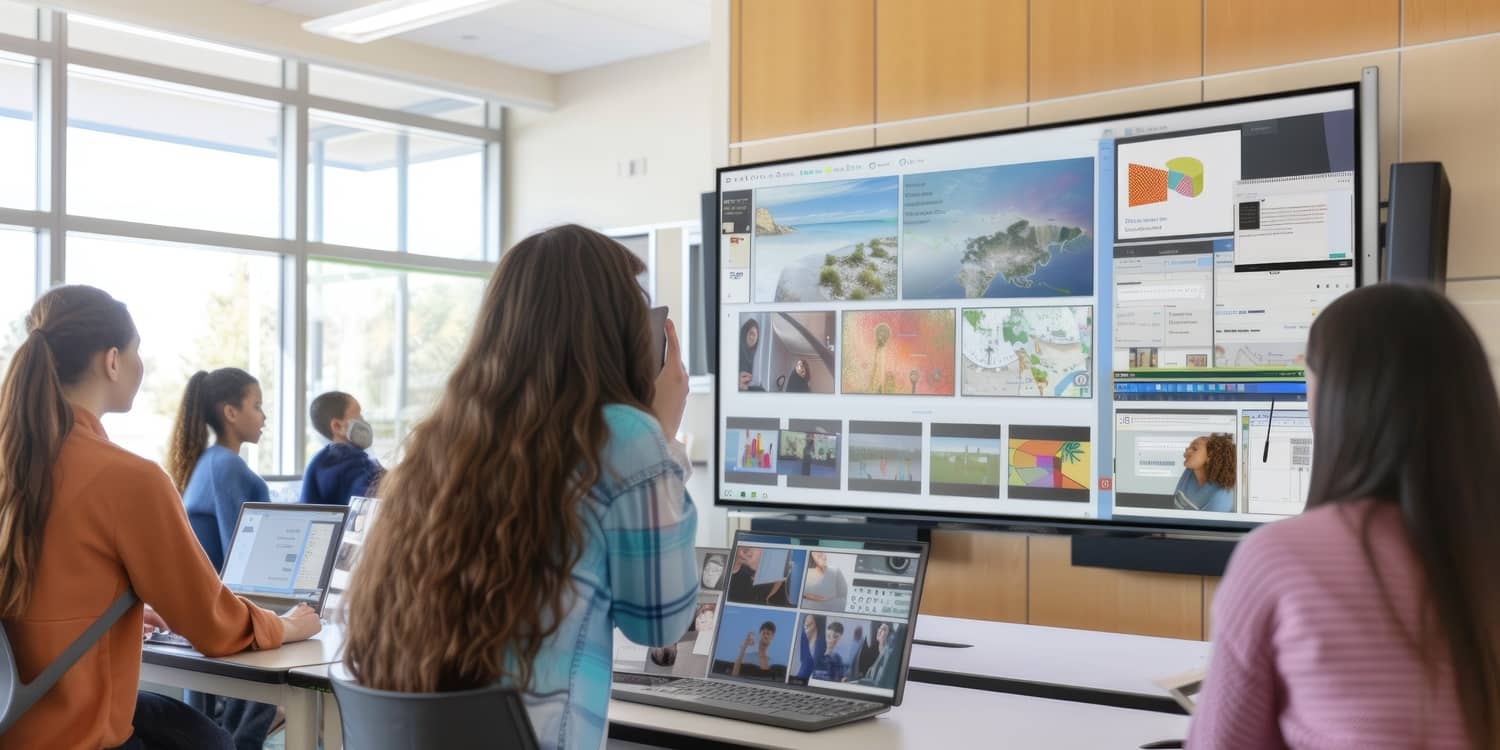In recent years, the concept of smart classrooms has gained momentum, reshaping the way students and teachers engage with learning. By integrating technology, smart classrooms offer a dynamic environment that fosters collaboration and critical thinking. This transition allows schools to enhance student engagement, streamline teaching methods, and make learning more adaptable to individual needs.
As educational institutions look to the future, making the shift to a smart classroom is becoming essential for staying ahead in providing quality education. In this guide, we’ll walk you through the key steps to make that transition smooth and effective.

1. Establish Goals and Needs
Start by asking what your school hopes to accomplish. Are you aiming to boost student engagement, make lessons more interactive, or offer personalized learning paths? Understanding these priorities will help shape your approach.
Next, consider the unique needs of students, teachers, and the curriculum. For students, think about how technology can support diverse learning styles and enhance accessibility. Teachers will need tools that integrate easily into their teaching methods and are user-friendly. The curriculum should also align with any tech solutions you choose, ensuring that the tools complement the subjects being taught rather than complicating them.
By laying out these goals and needs from the start, you’ll create a strong foundation for a successful transition.
2. Invest in Core Technologies
When transitioning to a smart classroom, one of the most significant steps is selecting the right technology. To create an interactive and engaging learning environment, start by focusing on a few essential tools.
Smart boards are a key element in modern classrooms. These interactive displays allow teachers to present lessons dynamically, integrating multimedia, annotations, and real-time collaboration. If you’re considering upgrading, smart boards for classrooms provide an all-in-one solution that replaces traditional whiteboards while offering much more versatility.
In addition to smart boards, tablets or laptops play a central role for students. These devices give students access to digital textbooks, educational apps, and cloud-based assignments, making learning more interactive and personalized.
Don’t overlook the importance of audio-visual systems. Investing in quality projectors, speakers, and microphones ensures that lessons are clear and accessible for all students, whether they’re in the room or joining remotely.
Lastly, consider adopting cloud-based platforms. These systems simplify classroom management by offering tools for assignment distribution, grading, and collaboration, all in one space. Cloud platforms also foster communication and teamwork among students, as they can easily share documents and work on projects together online.
3. Teacher Training and Support
A successful transition to a smart classroom depends heavily on how well teachers are prepared to use new technology. To ensure educators are equipped, schools should offer structured professional development that focuses on practical application.
Professional development should focus on integrating technology into everyday teaching. Workshops and training sessions can introduce tools like smart boards and tablets while emphasizing how to use them to enhance learning outcomes. These sessions should be interactive, allowing educators to explore the technology in realistic teaching scenarios.
It’s also essential to have ongoing technical support in place. Teachers should have access to reliable assistance whenever they encounter issues, whether through an in-house IT team, a help desk, or digital resources such as tutorials and user guides. This support ensures that technical challenges don’t disrupt learning.
Encouraging collaboration among teachers is another key aspect. Schools can set up systems where educators share lesson plans, resources, and strategies for using new technology effectively. This peer-to-peer sharing fosters a learning community and allows teachers to support each other in mastering new tools.
4. Develop a Cybersecurity Plan
A well-structured cybersecurity plan is essential to protect sensitive information and comply with educational data protection laws.
Safeguarding Student Data
With the increased use of digital tools, smart classrooms rely on vast amounts of student data—grades, attendance, personal information, and more. Implementing robust security measures is critical to protect this information from unauthorized access. Schools should adopt strong encryption methods for storing and transmitting data, ensuring that only authorized personnel can access it.
In addition, using multi-factor authentication (MFA) and regularly updating passwords help enhance security. Schools can also invest in firewalls and anti-malware software to guard against potential threats such as hacking attempts or ransomware attacks.
Securing School Systems
Smart classrooms are powered by various devices, all of which are connected to the school’s network. To ensure these systems run safely, network security protocols should be implemented. This includes setting up secure Wi-Fi networks, segmenting access between staff and students, and routinely updating software to patch any vulnerabilities.
Regular system audits and monitoring are also essential to identify any potential risks early on. A dedicated IT team should oversee system maintenance and respond to any security incidents promptly.
Ensuring Legal Compliance
Schools must also be mindful of data protection laws that govern the handling of student information, such as the Family Educational Rights and Privacy Act (FERPA) in the United States. Compliance with these regulations not only protects the school legally but also fosters trust among parents and the school community.
To stay compliant, schools should create clear data privacy policies that outline how student information is collected, stored, and shared. Regular staff training on these policies helps ensure that everyone understands their role in maintaining data security.
5. Pilot and Gather Feedback
Choose a handful of classrooms to serve as a test environment for the new technologies. These classrooms should be diverse in terms of subjects and grade levels to provide a well-rounded picture of how different students and teachers interact with the tools. During this phase, it’s essential to ensure that teachers involved in the pilot have all the necessary training and support. IT staff should be readily available to assist with any technical issues that arise.
Collecting Feedback
Throughout the pilot program, gathering feedback from both teachers and students is key to refining the approach. Teachers can provide valuable insights into how the technology impacts their lesson planning, instructional methods, and student engagement. In addition to teacher input, students can share their experiences, offering a perspective on how user-friendly the tools are and how they affect their learning experience.
Feedback collection can take various forms, such as surveys via written communication or digital format, focus groups, or one-on-one discussions. Encouraging honest and detailed responses will help identify strengths, weaknesses, and potential improvements.
Refining the Approach
Once feedback has been collected and analyzed, schools should take the time to adjust and refine their strategy. This may involve tweaking software settings, adding more training, or even rethinking which tools are most effective. Implementing changes based on real-world classroom experiences ensures that the final rollout will be smoother and more successful.

Moving Forward with a Smart Classroom
The move to a smart classroom requires thoughtful planning and a step-by-step approach. By setting clear objectives, selecting the right technologies, providing training, ensuring cybersecurity, and testing the setup through a pilot program, schools can ensure a smooth and effective transition.
This transformation not only modernizes education but also empowers teachers and students with tools that make learning more interactive and accessible. With the proper foundation in place, schools can create a tech-enabled environment that supports innovative teaching and prepares students for future success.




